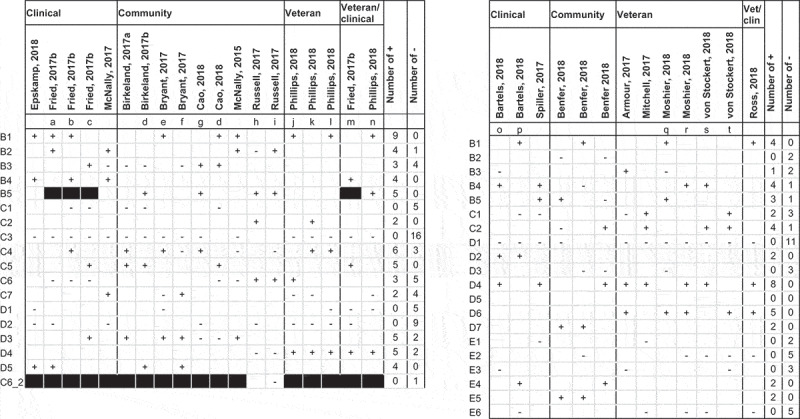Figure 2.

Top three and bottom three nodes according to node strength. DSM-IV (left), and DSM-5 (right).
Black: Node not present in network*. Fried (2017b): In data 1 and data 2 B4 and B5 were measured as one item, in data 3 and data 4 B4 and B5 were collapsed into a mean. Notes: a = data 1, b = data 2, c = data 3, d = females, e = acute, f = longer-term, g = males, h = younger, I = older, j = subthreshold, k = low exposure, l = high exposure, m = data 4, n = full criteria, o = children, p = caregivers, q = CAPS, r = PCL-5, s = T1, t = T2. Left panel: DSM-IV: B1: recurrent thoughts of trauma, B2: recurrent dreams of trauma, B3: flashbacks, B4: psychological cue reactivity, B5: physiological cue reactivity, C1: avoidance of thoughts of trauma, C2: avoidance of reminders of trauma, C3: memory impairment, C4: diminished interest in activities, C5: feelings of detachment from others, C6: restricted range of affect,C7: sense of foreshortened future, D1: sleeping difficulties, D2: irritability or anger, D3: difficulty concentrating, D4: hypervigilance, D5: exaggerated startle response, C6_2: Numbness sad/anger. Right panel: DSM-5: B1: recurrent thoughts of trauma, B2: recurrent dreams of trauma, B3: flashbacks, B4: psychological cue reactivity, B5: physiological cue reactivity, C1: avoidance of thoughts of trauma, C2: avoidance of reminders of trauma, D1: memory impairment, D2: negative beliefs, D3: distorted blame, D4: persistent negative emotional state, D5: diminished interested in activities, D6: feelings of detachment from others, D7: inability to experience positive emotions/restricted range of affect, E1: irritability or anger, E2: reckless/self-destructive behaviour, E3: hypervigilance, E4: exaggerated startle response, E5: difficulty concentrating, E6: sleeping difficulties.
